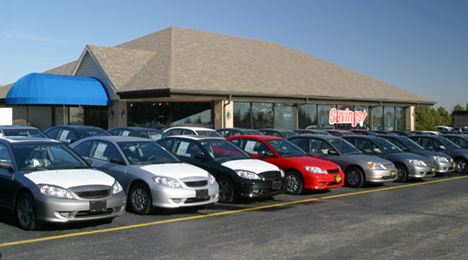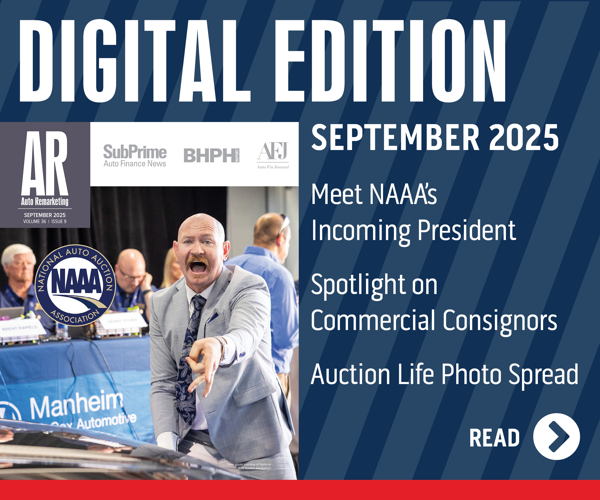Less than two months after Mark Floyd took the reins again as chief executive officer of Exeter Finance Corp., the interim leader used SubPrime Auto Finance News as a conduit to relay a message to dealers already in the subprime auto finance company’s network or stores considering it as a financing source for their retail customers.
After completing a year that included significant changes in how the company functions, Floyd insisted that “a big focus is service to our dealers. The dealers are obviously very important and critical to our success. We’re looking at how we can improve our service to dealers.
“I think our decision times are second to none in the industry,” he continued. “We have a dedicated sales team in the local market that are the face of the organization to our dealer customers. We offer competitive programs.
“But we also know we have areas in which we can improve,” Floyd added. “Those are our top priorities. We want dealers to get the attention they deserve. … That’s where the business begins.”
Floyd’s position with Exeter intensified again back on Dec. 8 when he returned as CEO on an interim basis following the resignation of Tom Anderson. The leadership change came after the finance company completed a major transformation from what Floyd described as “a decentralized branch network to a centralized model.” Now Exeter processes contracts and completes other work from its headquarters in Irving, Texas, along with another facility in Clearfield, Utah.
“That was a very dramatic change for the organization,” Floyd said. “It positions us for the future very well. All the major changes have been done. It’s good to be able to say that. That was a big accomplishment that wasn’t easy. Our team here at every level of the company is really focused and energized and ready to move forward so that’s really good to have that in our rear view mirror.
“Now we’re focused on the task at hand and moving forward,” he went on to say.
Part of moving forward for Exeter is continuing to gather dealer feedback about its processes and responding accordingly.
“Any change that dramatic is going to get mixed results. My perspective is (dealers) see the benefit of what we’ve done,” Floyd said.
“When you’re going through change that dramatic, a few things fall through the cracks here and there,” he continued. “We try to stay close with the dealers and ask for their honest feedback. And we all know they’re honest with their feedback, which is great. We’re taking that feedback and using it to improve what we have.
“For the change that we went through, I would rate the feedback as OK. But as you would expect, there are areas where we could have done better and we will do better,” Floyd went on to say.
Floyd is upbeat that not only will Exeter satisfy the dealers already in its network, but that more stores will start to send installment contracts its way.
“There is a universe of dealers where we haven’t even tapped into yet. We have an opportunity to expand our base. That’s part of our focus for 2016,” he said.
Along with his duties with Exeter, Floyd also is the current president of the National Automotive Finance Association. He touched on how the industry in general is functioning during his recent phone conversation with SubPrime Auto Finance News.
“The competition still is behaving rationally. That’s always a good thing for the industry. I continue to see that so it’s very encouraging,” he said.
“I really do believe the industry has learned lessons from the past,” Floyd continued. “There are always going to be some bumps along the way, but everybody’s antenna are up on any changes that might be coming and are responding appropriately. I’m encouraged about what I see and the outlook is very positive.”
Floyd also is quite positive about Exeter’s future now and when another CEO takes over the finance company.
“I couldn’t be more excited about the prospect for Exeter,” he said. “We have a strong capital structure in place and probably the best financial sponsor in the business in Blackstone. We have outstanding bank partners and strong consistent support for our securitization program.
“When I look at the industry, look at our strong capital structure at Exeter, look at the quality of people we have and everybody’s engagement in the business for what we see as the future, all of the pieces are in place for Exeter. It’s a good time to be at Exeter,” Floyd went on to say.
If you’ve been in this business for any length of time, you’re no doubt familiar with the spot delivery. That’s when a dealer signs a contract with a customer, allowing them to take possession of their new car before they’ve even received bank approval. It’s a practice about as old as the industry itself — and one that’s also fraught with risk.
Back in my retail days, I worked with numerous general managers who didn’t think twice about spot deliveries. They’d espouse the notion that if you weren’t bringing enough cars back, you just weren’t spotting aggressively enough! Their motto seemed to be: “If the customer can fog a mirror, we’ll spot them.”
The fact that spot deliveries still occur today seems a bit of a mystery. With the advent of technology and the development of channels like Dealertrack, RouteOne and CUDL, you’d think the practice would have gone the way of the DeLorean. This is hardly the case.
Many dealers will stop at nothing to put a deal together, including pushing spot deliveries. This is a frequently used tactic to remove a buyer from the market until the dealer has had enough time to hash out the particulars with the lender. This effectively keeps the buyer from going elsewhere while waiting for approval and limits the risk that they’ll be scooped up by the competition.
Often times, dealers bank on catching lenders asleep at the wheel. But it’s when third-party financing can’t be obtained at the quoted rates that things start to get messy. That’s when the customer is called back into the dealership and presented the cold hard facts by the F&I manager: The deal was not approved on the original terms offered. In order to keep the car, they’ll have to resign on higher payments or different terms.
Although many states have no laws in place preventing the practice of spot delivery, there are several conditions that apply. For example, it’s considered a deceptive practice to have a customer sign a contract on terms you know they may not be approved for. This is commonly known as a “yo-yo” deal, and can lead your dealership into a world of trouble — not the least of which could result in a class action lawsuit.
When spot deliveries go bad
Spot deliveries gone bad often result in one of two scenarios: recontracting and unwinding. Unwinding is a more straightforward action, resulting in the complete cancellation of terms and the return of the vehicle to the dealership.
Recontracting is the most common result of failed spot deliveries. That’s when the original contract is rescinded and a new contract is written up, this time for terms more likely to result in a third-party approval. Some states, like California, require the use of specific forms when recontracting customers. These forms also typically require dealers to provide full disclosure for the reasons why.
Recontracting is a sticky practice. Many dealers aren’t aware that back-dating contracts isn’t legal. All recontracted deals must show the new date of the contract. If not, this may lead to the inaccurate disclosure of a stated APR — a major no-no that can cause your dealership to be hit with a Truth in Lending Act violation.
Stips and liabilities
Another common mistake dealers make is letting customers slip on stip collections, attempting to collect stips only after the customer has taken possession of the vehicle. This practice can open you up to significant risk — like the customer being unable to offer proof of income, or the provided proof of income not matching what was entered into the application.
In this case, you as the dealer will have no choice but to send the deal to another bank. This provides customers with anywhere from two weeks to 45 days to shop the loan without adversely impacting their credit. If credit is pulled outside of that allowance, it may damage the customer’s credit file. This can leave your dealership liable. The solution? Never let the customer leave without validating their income and without all stips in hand.
Insurance and liability
Yet another danger inherent in the spot delivery is the question of insurance in the event of an accident. If a customer drives a new car off the lot and gets into an accident — wrapping the vehicle around a telephone pole and injuring others in the process — your dealership will be responsible for paying for the damages. In this scenario, an insurance provider is not obligated to pay the claim. It’s not until the transaction is fully funded by the bank that insurance kicks in.
State requirements vary
Some states require dealers to obtain bank approval within a specific time frame. Recently, New Jersey revised spot delivery time frames to four days. If bank approval can’t be obtained within that time, the customer has to return the vehicle. Once outside that four-day allowance, customers can demand the originally contracted terms – leaving the dealership responsible for providing in-house financing. In-house financing, also known as full recourse, can open up a can of worms with respect to various regulations.
Other states have different rules about spot delivery. In Wisconsin, dealers there are required to provide financing if they spot deliver a vehicle and can’t get the customer approved through a third-party lender. Because state laws differ, ensure you are up to speed on where your state stands with respect to spot delivery.
Deferred down payments and promissory notes
Often, dealers offer to hold checks or promissory notes to defer the customer’s down payment when doing a spot delivery. While this may not be considered illegal by FTC standards (as long as no interest is charged to the customer and you’ve been fully transparent), it could raise serious issues with your bank provider.
If the customer fails to make payment to the lender and the lender discovers your dealership accepted a deferred down payment or promissory note in lieu of actual money down, your dealership could be on the hook for the full value of the car. Naturally, much of this has to do with your established relationship with the lender in question – but it’s a risk better not taken. As a point of caution, always read your dealer agreement and closely review your retail installment sales contracts.
No such thing as a free ride
Spot deliveries offer numerous conveniences for both customers and dealerships. Customers can drive their new vehicle off the lot much sooner, and dealerships enjoy selling more cars. But spot deliveries also come wrapped in risks that must be considered. Spot decisions can wreak havoc in the wrong hands. As a dealer, it’s imperative that you examine the potential pitfalls of spot delivery and determine if the risks to you outweigh the benefits.
Rebecca Chernek of Chernek Consulting provides customized in-dealership training for franchised, independent and high-line luxury brand automotive dealers. Interactive virtual training programs in conjunction with role play, including a recently added course on compliance, are available at www.chernekconsultingvirtualpro.com.
With contract terms continuing to lengthen, perhaps this year’s contingent of Best Resale Value Awards from Kelley Blue Book might provide finance companies with vehicles to enhance underwriting and origination decisions.
The 2016 model-year brand and category winners of the annual award program recognizes vehicles for their projected retained value through the initial five-year ownership period.
“KBB Best Resale Value Award winners are great for long-term financing because they increase the odds that the vehicle will have equity should the customer or the finance company have to sell the asset prematurely,” said Eric Ibara, director of residual values at Kelley Blue Book.
"By definition, BRVA winners enjoy greater consumer demand which helps the vehicle retain its value better than average," Ibara continued.
For the second year in a row, Subaru and Lexus earned top honors for best brand and best luxury brand (respectively), with Subaru claiming four model winners and Lexus producing six model winners from a total of 22 different segments.
In addition, Toyota and General Motors each have an impressive five models winning 2016 Best Resale Value Awards, Porsche has two models taking home resale value honors this year, and Tesla is receiving its first-ever Best Resale Value Award.
“Lexus notably captured the top luxury brand award for the fifth year in a row, and after previously winning the brand award in 2011 and 2015, Subaru is back on top once again for 2016 as the best mainstream brand for resale value across its entire lineup,” Ibara said.
“While both Subaru and Lexus deliver incredible resale value, we also continue to be impressed with General Motors, which tops domestic automakers with seven combined awards for Chevrolet and GMC and places four of its vehicles in our Top 10,” he continued.
“In addition, the majority of the Top 10 Best Resale Value vehicles this year are trucks and SUVs, which is further testament to the strength these segments will carry in the future. Five out of the Top 10 vehicles with Best Resale Value for 2016 are pickup trucks,” Ibara went on to say.
Kelley Blue Book's Best Resale Value Awards are in its 14th year and are based on projections from the Kelley Blue Book Official Residual Value Guide. Kelley Blue Book Residual Values are established by experienced automotive analysts that review the output from the statistical models built upon millions of transactions.
Vehicles that earn the highest five-year residual values, expressed as a percentage of their original manufacturer’s suggested retail price (MSRP), are selected for these awards. Low-volume vehicles and vehicles with an MSRP of more than $60,000 are excluded from award consideration, except in the plug-in vehicle, luxury and high-performance categories.
KBB's 2016 Best Resale Value: Top 10 Cars
| Chevrolet Camaro |
Subaru Forester |
| Chevrolet Colorado |
Subaru WRX |
| GMC Canyon |
Toyota 4Runner |
| GMC Sierra |
Toyota Tacoma |
| Jeep Wrangler |
Toyota Tundra |
Here's the full list of KBB's 2016 Best Resale Value Awards by vehicle category:
KBB's 2016 Best Resale Value: By Vehicle Category
| SUBCOMPACT CAR: Honda Fit |
PLUG-IN VEHICLE: Tesla Model S |
| COMPACT CAR: Subaru Impreza |
COMPACT SUV/CROSSOVER: Jeep Wrangler |
| SPORTY COMPACT CAR: Subaru WRX |
MID-SIZE SUV/CROSSOVER: Toyota 4Runner |
| MID-SIZE CAR: Subaru Legacy |
FULL-SIZE SUV/CROSSOVER: Chevrolet Tahoe |
| FULL-SIZE CAR: Toyota Avalon |
LUXURY COMPACT SUV/CROSSOVER: Porsche Macan |
| ENTRY-LEVEL LUXURY CAR: Lexus RC |
LUXURY MID-SIZE SUV/CROSSOVER: Lexus GX 460 |
| LUXURY CAR: Lexus GS |
LUXURY FULL-SIZE SUV/CROSSOVER: Lexus LX 570 |
| HIGH-END LUXURY CAR: Porsche Panamera |
HYBRID SUV/CROSSOVER: Lexus RX 450h |
| SPORTS CAR: Chevrolet Camaro LT |
MID-SIZE PICKUP TRUCK: Toyota Tacoma |
| HIGH PERFORMANCE CAR: Chevrolet Camaro SS |
FULL-SIZE PICKUP TRUCK: Toyota Tundra |
| HYBRID/ALTERNATIVE ENERGY CAR: Lexus ES 300h |
MINIVAN/VAN: Toyota Sienna |
Editor’s note: Sister publication Auto Remarketing also talked with Ibara to get more details about KBB compiled this year’s list of honorees for a report available here.
TransUnion’s 2016 auto loan forecast — including its projection that delinquency rates are likely to remain unchanged — should allow the subprime auto finance industry to maintain two of its most important positions that can satisfy both consumers and perhaps regulators, too.
Overall economic stability is likely to help finance companies originate more contracts with subprime consumers, who in turn can eventually elevate themselves out of lower credit tiers because of the resources to maintain repayment terms.
Here are the forecast details shared on Monday that helped TransUnion senior vice president and automotive business leader Jason Laky arrive at those assertions.
TransUnion’s forecast projects that delinquencies will remain stable throughout the next year (with normal seasonal variance), with delinquency levels unchanged at 1.11 percent between year-end 2015 and year-end 2016.
While delinquency rates stay flat, TransUnion is forecasting that auto loan balances will continue to rise, with average auto loan debt per borrower expected to increase from $17,985 in Q4 2015 to $18,509 in Q4 2016.
TransUnion forecasts the average balance will surpass $18,000 in Q4 2016, a growth of more than $1,000 over the past two years. By the end of 2016, auto loan debt per borrower will grow more than $3,500 from Q4 2009, when the average balance was $14,956.
And what about the subprime slice of the market?
TransUnion data shows that the number of auto loans has grown every quarter since Q3 2011. In Q3 2015 (the most recent data available), the number of auto accounts grew to 69.4 million, up 8.2 percent from 64.2 million in Q3 2014. The number of auto loan accounts has grown 15 million from Q3 2011 to Q3 2015.
Despite an increase in the number of auto loans, fewer subprime consumers (those with a VantageScore 3.0 credit score lower than 601) had an auto loan in the third quarter of 2015 than in 2009. In Q3 2009, subprime auto loans comprised 23.7 percent, or 14.8 million, of all loans. By Q3 2015, the subprime share of auto loans declined to 18.7 percent of the total, or 13.9 million consumers.
Of those holders who took contract back in 2009, there’s a chance a segment of that population no longer is even considered subprime, reinforcing an industry refrain about how subprime auto financing can help consumers get back on their financial feet.
“It’s a function of how credit scoring works. If credit scores work correctly, they should reward good financial behavior and decisions, which are as most credit scores indicate, paying your obligations on time, not taking on too much credit relative to your outstanding availabilities and prudently seeking out new credit,” Laky said.
“One of the things I think for subprime borrowers taking out an auto loan is to make the payments as expected. That probably more than anything will help move their scores out of subprime,” added Laky, who worked at a subprime auto finance company before joining TransUnion.
And whether or not it’s a consumer in the subprime credit bucket, auto loan holders are paying on their notes at a greater pace, and TransUnion thinks they will continue to do so.
As average auto loan debt levels rise, TransUnion sees minimal changes in the auto delinquency rate in 2016. Aside from quarterly changes as a result of seasonality, TransUnion forecasts auto delinquencies will remain near all-time low levels. Since auto loan delinquency peak levels in Q4 2009 (1.54 percent), delinquency rates have declined 28 percent.
“For the last two years, auto delinquency has remained low as consumers prioritized their auto loan payments,” Laky said. “Through the end of 2016, we expect the auto delinquency rate to remain stable at historic, seasonal norms. We believe we have reached a ‘new normal’ in auto delinquency and see no immediate cause for concern.”
Laky elaborated about that point during a conversation with SubPrime Auto Finance News.
“One of the best indicators of your ability to take on and meet your obligations on a new auto loan is your past auto loan performance,” he said. “If you’re a subprime or non-prime consumer getting into a loan, if you manage to stay up to date and limit the amount of times you’re delinquent on the loan, you put yourself in a great position, not just with your current lender but any other lender as you look for your next auto loan.
“They’re going to say, ‘Here’s a consumer who took out an auto loan obligation, managed to make their payments on time for a year or two or three years.’ Now they’re looking to get something new. They might not have taken a chance before but now that they have a proven track record, (the finance company) might say, ‘I’m going to do it,’” Laky continued.
“Subprime lenders, in effect, perform a very important role in helping consumers establish credit because as good prudent underwriters it is in their best interest, too, to ensure that the consumer gets the right amount of auto loan they need to balance the car want versus their ability to repay the loan,” he went on to say. “Subprime lenders that do that right and do it well with the consumer, help the consumer create a good track record of finance to give them opportunities later.”
TransUnion’s forecast also shed a little light on how those track records might form.
On a state level, auto delinquencies are expected to rise in 27 states from 2015 to 2016 with the locations projected to experience the largest increases in delinquency including:
— Hawaii: up 8.68 percent
— Oklahoma: up 7.06 percent
— Nebraska: up 7.02 percent
States projected to experience the largest declines in auto delinquencies include:
— North Carolina: down 6.05 percent
— Florida: down 5.85 percent
— Kentucky: down 5.15 percent
— Oregon: down 4.16 percent
No matter which states experience delinquency movements, might the industry have to address the term that makes some industry participants cringe? What about the much ballyhooed subprime bubble?
“The data appear to refute the apprehensions about a subprime bubble — and may even point to an opportunity for growth in subprime auto lending,” Laky said.
“While auto lenders are certainly extending loans and leases to consumers who present a higher risk, these consumers have been able to manage their auto loan obligations in line with expectations,” he continued.
“As auto lenders incorporate trended data into their analyses, we may see even more consumers receiving auto loans as lenders more effectively underwrite previously unscorable consumers,” Laky went on to say.
That potential growth — and finance companies taking on more risk — could be the other industry position leaders can tout in 2016. Laky explained the potential stems from overall market indicators that point to job growth and reasonable gas prices.
“With our stable, growing economy and the continued healthy pace of job growth, consumers are feeling confident enough to take on new auto loans, resulting in a healthy equilibrium between growing balances and low delinquency rates,” Laky said.
“Robust consumer loan performance, combined with declining gas prices and low interest rates, will allow lenders to offer slightly larger auto loans to consumers in the coming year without putting their portfolios at risk,” he continued.
“When those things come together, it’s really good for subprime lenders,” Laky went on to say. “It gives them the confidence to reach out and make loans to folks that when you’re worried about the economy, you might pull back and not make those loans. That confidence should lead to expanded lending across the whole credit spectrum.”
Ally Financial announced this week that the finance company now will have full eContracting capabilities available to dealers nationwide through RouteOne’s indirect auto financing platform.
Executives explained the solution can provide retail contract validation, signature and distribution — all done electronically. It is supported by open integrations to leading dealer management system (DMS) providers in the U.S. dealer market.
“We are pleased to have Ally become part of eContracting on RouteOne,” RouteOne chief executive officer Mike Jurecki said.
“The availability of leading financial sources, like Ally, further drives the adoption of eContracting by dealers, and enhances the entire vehicle purchasing journey for all parties involved: Dealers, finance sources and customers,” Jurecki continued.
Jurecki went on to emphasize RouteOne has a long and proven track record with eContracting. Its volume more than doubled in 2014 and by the close of 2015, is on target to exceed 4.5 million eContracts booked since inception.
The company added momentum continues to accelerate, due to strong participation by finance sources and a growing list of more than 5,000 dealers, with coverage in all 50 states.
Growth is further building because dealers can easily leverage their current DMSs and other DSPs in support of the eContracting process through open integrations to the RouteOne platform.
Furthermore RouteOne eContracting can provide compliance auditing throughout the entire contracting life-cycle and a flexible, consumer-friendly signing process that can be done using signature pads, tablets, or nearly any touch-screen device.
The addition of Ally to eContracting through RouteOne’s platform is designed to reflect Ally’s digital capabilities and commitment to an industry that is shifting toward a digital marketplace.
“eContracting provides a variety of benefits to our dealers and streamlines the transaction for the consumer,” said Tim Russi, president of auto finance at Ally.
“Ally continues to invest in our technology to provide dealers the tools for faster funding and increased customer satisfaction,” Russi added.
Dealers and finance sources interested in eContracting can contact RouteOne at (866) 768-8301.
The combination of investor money and an online platform created by what the company calls an “A team” of industry veterans who have collectively more than 110 years of experience in automotive, below-prime automotive finance, billions of dollars of securitization execution and asset performance management generated a new website — SpringboardAuto.com.
On Wednesday, the site founders Jim Landy and Stuart Holmes described SpringboardAuto.com as a new direct-to-consumer auto loan platform that “completely reinvents the auto lending experience.”
SpringboardAuto.com originates and services loans for institutional investors. Providing an alternative to investors purchasing prime unsecured assets, SpringboardAuto.com offers loans to below-prime borrowers that are secured by a high utility asset.
Based in Irvine, Calif., the company is set to launch the new auto loan service early next year. SpringboardAuto.com is designed to enable consumers to refinance existing auto loans, or finance the purchase of a new or used vehicle directly online or via a smartphone, leveraging data and analytics to facilitate a fast, convenient, and transparent online loan process.
SpringboardAuto.com founders insisted that their new site can provide benefits for all stakeholders:
1. Consumers
Unlike other models that seek to monetize the loan applicant via the dealership, SpringboardAuto.com is designed to put the consumer in control and at the center of the loan process, offering faster decisions and online tools.
“SpringboardAuto.com will ultimately deliver a better consumer experience,” officials said.
“Consumers will have insight into information they may not otherwise be privy to in other lending models,” the continued. “Consumers will see how choices they make as they configure their loan, in variables such as loan term and reduced sale price, effect their overall final loan obligation.
2. Private Party Sellers/Buyers
The founders explained SpringboardAuto.com’s platform can bridge existing process challenges with private party transactions by enabling buyers and sellers to securely and easily transact and close their vehicle purchase and sale within the website.
“This includes everything from financing and inspections to DMV paperwork,” they said.
3. Dealers
Officials added that SpringboardAuto.com can fund loan applicants for a specific vehicle and funnel the qualified customer directly to the dealership at no charge.
“Even with lost rate mark-up, this transaction is a much more efficient below prime transaction for dealers when you account for the elimination of any lender fees, discounts and lead fees,” the founders said.
“The SpringboardAuto.com process will reduce the hours typically spent with subprime customers,” they added.
According to the recent Car Buyer of the Future study by Autotrader, nearly three-fourths of consumers want to complete credit applications and financing paperwork online. Among the key factors driving this trend is a desire to save time at the dealership and have less pressure while filling out paperwork.
Furthermore, a recent study from PriceWaterhouseCoopers showed that the overall experience — including speed, transparency and customer service — often trumps interest rate as a consumer’s biggest consideration when choosing a lender.
“The market for auto loans has changed dramatically over the past few years, yet auto lenders have not kept up with today’s consumer demands, especially those of the technical-savvy millennials who live and breathe on their smartphones and account for 37 percent of all funded auto loans,” said Landy, who is chief executive officer of SpringboardAuto.com.
“In general, borrowers, especially those with less than perfect credit, are incredibly dissatisfied with the opaque and frustrating car-financing process. Our mission is to change that.”
Holmes also reiterated how the site is geared to benefit its users
“Our goal is not to simply digitize the same old process; instead, our platform, which is fully mobile optimized, will speed it up by reducing redundant data and endless document requests — all while minimizing potential impact on an applicant’s credit score,” said Holmes, chief marketing officer of SpringboardAuto.com.
“And, ultimately, the entire process will happen easily and efficiently — from loan, to trade-in, to final purchase — for both private party and dealer purchase,” Holmes went on to say.
Auto Financial Group — an online provider of innovative financing products including CarMark Auto Finance for credit unions and banks — announced year-to-date growth figures this week, revealing increasing momentum in new customer signings with AFG’s balloon lending and remarketing programs.
Since August, Auto Financial Group highlighted that it has signed nine new credit unions to their Balloon Lending program, resulting in a reach increase of more than 185,900 new consumers. These new organizations include:
— Align CU
— Anoka Hennepin Credit Union
— Arlington Community Federal Credit Union
— BrightStar CU
— Education First CU
— Hialeah Municipal Employees FCU
— Jamestown Area Community FCU
— MOBILITY CU
— Vermont FCU
The company tabulated that these credit unions represent combined assets of more than $2 billion through institutions located across Florida, Massachusetts, Minnesota, New York, Texas, Vermont and Virginia.
“We welcome these financial institutions to the growing AFG family," AFG chief executive officer Richard Epley said. "Residual based financing is at an all-time high in the U.S., and we're excited that these institutions have chosen AFG’s Balloon Lending Program to offer to their members."
In addition, Auto Financial Group has signed four new credit unions as remarketing partners, resulting in a reach increase of more than 579,000 new consumers. These new remarketing partners, representing combined assets of more than $3.9 billion, include:
— Intouch Credit Union
— Municipal Credit Union
— My Community Federal Credit Union
— Smart Financial Credit Union.
Auto Financial Group expects continued growth through the remainder of 2015, leading into a strong 2016 as the company seeks to provide their unique financing products and solutions to financial institutions across the U.S.
The balloon lending program, such as CarMark Auto Finance, can provide institutions with a residual based balloon loan program that is fully insured.
Through AFG's software, financial institutions are able to secure higher-yielding loans with lower monthly payments for their consumers, mitigate residual value risk, and position themselves to take advantage of the record market increases in residual value based financing.
Equifax highlighted the total amount of subprime auto loans originated through August and connected to consumers with an Equifax Risk Score below 620 totaled $75.8 billion, representing a 12.6-percent increase year-over-year.
In an effort to help dealerships and finance companies generate the most gross from that activity, ProMax Unlimited chief executive officer John Palmer again pinpointed what his company spotted as the top grossing vehicles purchased by subprime customers.
In the lists below, Palmer noted the top 20 highest grossing vehicles in three different subprime credit tiers. Vehicles are ranked in order of total units sold, not total gross.
Again through the first eight months of 2015, Equifax reported 4.2 million vehicle installment contracts have been originated with subprime customers, constituting about 22 percent of the entire market.
Equifax also mentioned the average subprime loan amount was $18,358. So what vehicles might be tied to those contracts? Here’s what ProMax Unlimited noted as what generated significant gross:
Credit Tier 575-619
1. 2013 Ford Fusion: $2,762.57
2. 2013 Chrysler 200: $2,852.49
3. 2013 Hyundai Sonata: $2,804.28
4. 2014 Ford Fusion: $3,544.28
5. 2013 Ford Focus: $2,067.39
6. 2013 Kia Optima: $3,119.98
7. 2014 Chrysler 200: $2,628.20
8. 2013 Ford Escape 4WD: $2,468.58
9. 2012 Ford Focus: $2,229.13
10. 2014 Chevrolet Malibu: $3,885.05
11. 2014 Ford Focus: $3,266.67
12. 2014 Nissan Altima: $2,664.42
13. 2012 Chevrolet Cruze: $2,962.98
14. 2014 Nissan Sentra: $3,857.59
15. 2014 Chrysler Town & Country: $2,949.67
16. 2014 Toyota Camry: $2,041.25
17. 2013 Chevrolet Cruze: $3,401.81
18. 2014 Dodge Avenger: $1,973.59
19. 2013 Hyundai Elantra: $1,791.21
20. 2013 Nissan Altima: $3,338.20
Credit Tier 520-574
1. 2014 Nissan Altima: $1,820.69
2. 2013 Chrysler Altima: $2,318.63
3. 2013 Nissan Altima: $2,942.28
4. 2013 Hyundai Elantra: $2,969.28
5. 2013 Ford Focus: $2,008.06
6. 2014 Toyota Corolla: $3,098.87
7. 2014 Chrysler 200: $3,011.21
8. 2014 Chevrolet Malibu: $3,560.13
9. 2014 Hyundai Elantra: $1,737.73
10. 2013 Chevrolet Malibu: $2,386.53
11. 2013 Ford Fusion: $2,283.80
12. 2013 Dodge Avenger: $3,665.44
13. 2011 Chevrolet Malibu: $3,678.63
14. 2013 Kia Optima: $2,462. 78
15. 2013 Hyundai Sonata: $2,263.89
16. 2012 Chevrolet Cruze: $2,094.76
17. 2013 Chevrolet Cruze: $2,030.65
18. 2014 Ford Fusion: $3,886.30
19. 2014 Hyundai Sonata: $2,609.02
20. 2015 Chrysler 200: $2,737.01
Credit Tier 460-519
1. 2014 Nissan Altima: $2,667.03
2. 2013 Chrysler 200: $1,943.10
3. 2012 Ford Fusion: $2,169.29
4. 2013 Dodge Avenger: $2,195.23
5. 2014 Ford Focus: $2,434.97
6. 2014 Toyota Corolla: $4,417.06
7. 2014 Toyota Camry: $2,597.46
8. 2013 Ford Focus: $2,054.46
9. 2013 Ford Fusion: $380.93
10. 2013 Hyundai Sonata: $3,203.64
11. 2014 Ford Fusion: $3,705.82
12. 2012 Nissan Altima: $2,764.92
13. 2014 Hyundai Accent: $2,018.15
14. 2014 Hyundai Elantra: $1,803.21
15. 2012 Toyota Camry: $4,433.47
16. 2014 Chevrolet Malibu: $3,383.28
17. 2013 Kia Optima: $2,683.04
18. 2014 Chrysler 200: $1,855.63
19. 2014 Dodge Charger: $1,764.83
20. 2012 Nissan Sentra: $3,122.84
Along with tapping an executive to fill the newly created role of chief sales officer, eLEND Solutions — a technology company delivering integrated credit, identification and finance solutions to dealers — recently announced the provider joined DealerVault’s Premier Network.
DealerVault is a cloud-based system that can empower dealerships with control over the syndication and distribution of their DMS data — regardless of the DMS system they use.
“Vendor integration is vital to creating a connected car-buying experience for consumers — which means moving them quickly and seamlessly from the website or showroom floor into the F&I department — and DealerVault’s secure DMS data feed provides a solution that makes this an affordable and easy-to-implement process,” eLEND Solutions chief executive officer Pete MacInnis said.
DealerVault’s Premier Network can allows third-party solution providers to actively support dealerships’ desire to take control of their data, providing a what executives called a “win-win” for vendors and dealerships alike.
“DealerVault helps eliminate any data knowledge gaps that may happen as a result of an expensive or difficult to penetrate DMS system,” MacInnis said.
DealerVault president and CEO Steve Cottrell added, “eLEND Solutions is playing a unique role in changing the way the car-buying experience works for dealers and consumers alike and we’re thrilled to welcome them as a Premier Network partner.”
The company went on to highlight this partnership will help eLEND Solutions further transition from a product provider into the next generation finance platform.
Leading its growth strategy, the eLEND Solutions recently appointed Pogo Parr, a 18-year automotive industry veteran, to the newly created role of chief sales officer.
Parr has extensive experience in building highly successful sales teams that have achieved dramatic revenue growth for multiple companies, including Autotrader, CallSource, Century Interactive, and, most recently, DealerOn.
“We’re thrilled to welcome Pogo to our team and know that he will build an effective and focused sales team that will bring eLEND Solutions’ products to a much wider base of dealer customers,” MacInnis said.
With eLEND Solutions having plans for aggressive growth during the next 3 years, the company just moved into its new headquarters in Foothill Ranch, Calif., more than doubling its office space.
As captive activity also registered gains, Experian Automotive highlighted on Wednesday that what it classifies as finance companies — institutions that don’t hold customer deposits but get most of their business from consumers with subprime and deep-subprime credit — gained a healthy amount of market share year-over-year during the third quarter.
According to the Q3 2015 State of the Automotive Finance Market report, finance company market share reached 13.34 percent in Q3, up 6.4 percent from the previous year.
Meanwhile, Experian indicated one of the biggest shifts in the automotive lending industry during Q3 was the resurgence of captive lenders — the lending companies owned by vehicle manufacturers.
In the third quarter, captive lenders financed 51.6 percent of new-vehicle loans, up from 36.8 percent in Q3 2011. This gain represents the largest market share of new-vehicle financing for captives since the recession.
Market share findings for other lending types show commercial banks still holding the largest share for new and used vehicle loans combined, at 34.7 percent.
“Captive lending has made a comeback since suffering a steep drop-off caused by declining new sales and lender-type shifts during the recession,” said Melinda Zabritski, Experian’s senior director of automotive finance.
“This is good news for manufacturers, as their captive finance companies often provide an additional source of revenue as well as a strong pipeline to credit for their dealer networks,” Zabritski continued
Experian mentioned five other interesting findings from its Q3 data, including:
• Consumers continue to rely on financing; the percentage of new vehicles financed reached an all-time high of 86.6 percent.
• The average credit score for a new vehicle loan fell to 710, the lowest since Q3 2007.
• During Q3, the average monthly payment for a new vehicle was $482, up $12 from the previous year.
• The average monthly payment for a used vehicle reached $361, an increase of $3 from a year ago.
• The average interest rate for a new vehicle hit 4.63 percent, while the average interest rate for a used vehicle reached 8.76 percent.
More leasing as contract terms lengthen
Experian has never seen this many new models roll over the curb connected to a lease.
Zabritski indicated leasing accounted for nearly 27 percent of all new-vehicle transactions in Q3, up from 24.7 percent the previous year. This level marks the highest percentage of vehicles leased since Experian began tracking the data publicly in 2006.
Findings from the report also showed that the average monthly lease payment was $398 during the quarter, up $1 from a year ago.
“As the price for a new or used vehicle continues to rise, leasing has become a more viable financing option for consumers looking to maintain an affordable monthly payment,” Zabritski said.
“While consumers can save an average of $84 per month by leasing rather than taking out a loan on a new vehicle, they should make sure leasing fits their lifestyle,” she continued. “Oftentimes there are mileage caps and other considerations that consumers should familiarize themselves with before entering into a leasing agreement.”
Rising vehicle prices also have given way to record loan amounts for new and used vehicles.
During the third quarter, the average amount financed for a new vehicle was $28,936, up $1,137 from the previous year.
The average amount financed for a used vehicle was $18,866, up $290 over the same time period.
Furthermore, Experian pointed out the gap between new and used loan amounts also has grown. On average, consumers finance $10,070 less on a used vehicle than on a new one.
Extending loan terms is another method consumers turned to in order to keep monthly payments low. During Q3, Experian determined the percentage of consumers who took out new and used vehicle loans with terms between 61 and 72 months reached all-time highs.
For new vehicles, approximately 44 percent took out 61- to 72-month loans, and more than 41 percent financed a used vehicle for the same duration.
Analysts noticed the percentage of consumers extending their loans even longer also has increased.
Loans for new vehicles extending 73 to 84 months increased 17.1 percent over the previous year, reaching a Q3 record high of 27.5 percent.
Used-vehicle loans extending in the 73- to 84-month term, however, reached an all-time high of 16.2 percent (a 12-percent increase over the previous year).












